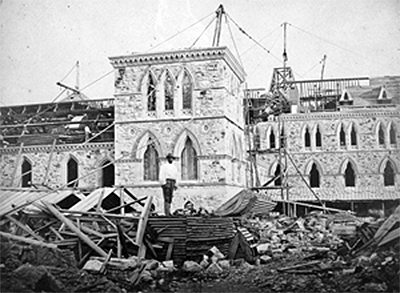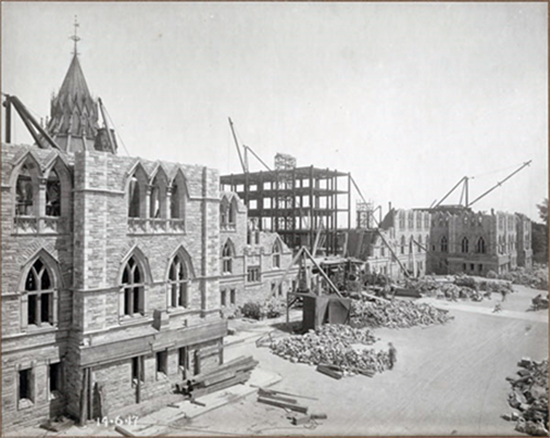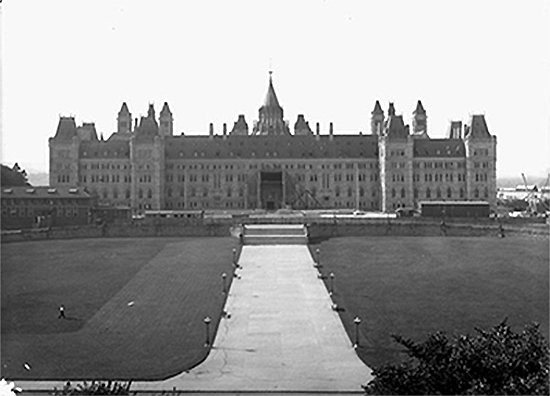Building and rebuilding Canada’s Parliament Buildings
After marking Canada’s 150th anniversary celebrations, Parliament Hill’s Centre Block will close for a large-scale restoration and modernization project. Public Services and Procurement Canada (PSPC) will carry out the work. PSPC will renovate the building on behalf of Canadians. It will ensure that our most important national symbol is preserved.
This article in the Celebrating Public Services and Procurement Canada’s History series looks back at the department’s role in constructing the Parliament Buildings.
Building the Parliament Buildings
When the Province of Canada was founded in 1841, its capital city moved from Kingston to Montréal. It then rotated between Toronto and Québec. The Department of Public Works (one of the departments that became Public Services and Procurement Canada) was responsible for these moves. Queen Victoria selected Ottawa as the permanent capital in 1857.
The government asked Public Works to build 4 federal buildings in Ottawa:
- 1 Parliament building (the Centre Block)
- 2 administrative buildings (the East and West Blocks)
- 1 Governor General’s residence
It was one of the largest building projects ever to be undertaken in the young nation of Canada.

The Parliament Buildings under construction in 1868. (Credit: Library and Archives Canada / C-003761, Samuel McLaughlin)
In 1859, Public Works held a competition to find suitable architects.
Thomas Fuller and Chilion Jones won the contract to design the original Centre Block. Charles Baillairgé contributed later. Thomas Stent and Augustus Laver designed the East and West Blocks. The Governor General’s home planned at that time was never built.
The buildings were all designed in a style called Gothic Revival. Public Works chose this style rather than neoclassic designs. At that time, neoclassical was popular in the United States. The Gothic Revival style was chosen because it went well with the landscape of Parliament Hill. It was also favoured because of the rich textures and decorative themes that spoke to the progressive spirit of the new nation.
Construction of the buildings began on December 20, 1859. The buildings officially opened on June 6, 1866.
In 1876, Public Works completed the Library of Parliament and the landscaped grounds of Parliament Hill. Later that year, the department built the wrought-iron Queen’s Gates at the main entrance of Parliament Hill.
Interesting fact
The department lit up the outside of the Parliament Buildings for the first time in 1897. Thousands of electric lights were turned on to celebrate Queen Victoria’s Diamond Jubilee.

The original Centre Block building on February 4, 1916, after the fire that started the night before. This view from the West Block shows the extent of the damage. In the photo, you can see the tower, which was replaced by the Peace Tower. In the back of the photo, you can see the Library, which survived the blaze.
(Credit: National Archives of Canada / Photographer: Samuel J. Jarvis)
Centre Block destroyed by fire
On February 3, 1916, a fire destroyed the Centre Block. Only the Library of Parliament survived.
In the aftermath of the fire, Public Works readied the Victoria Memorial Museum (now home to the Canadian Museum of Nature) overnight so that the House of Commons would have a place to sit the next day, a Friday. By the following Monday, the museum boasted:
- a Senate Chamber
- offices for members of Parliament
- committee rooms
Rebuilding Centre Block
After the fire, Public Works began constructing a new Centre Block building almost immediately. The government began construction while Canada was still fighting in the First World War.
While Public Works cleared the rubble from the site, the architects developed and submitted their plans to the government.
John A. Pearson and Jean-Omer Marchand were the architects chosen for the project. They quickly ruled out merely rebuilding a replica of the old 4-storey building. The new Centre Block was made as a modern Beaux-Arts building with a Gothic Revival decorative scheme. The new building was a 6-storey steel-reinforced stone building. It is about 143 metres long by 84 metres wide. Although it has almost the same footprint as the original 4-storey building, it has 47% more interior space. The architects also used more modern construction techniques like:
- steel-frame construction
- load-bearing concrete
- fire-proof materials
Where the interior of the old Centre Block was mostly wood, the current Centre Block’s interior is mostly stone and marble. The architects chose stone so that if there was another fire, it would not spread as quickly. The architectural planning of the building is based on Beaux-Arts principles.
Despite the pressures of the First World War, Public Works constructed the building fairly quickly. At the time, many of Canada’s resources were going towards the war effort.
The new Centre Block opened in 1922.
Pearson and Marchand designed the Peace Tower as an expression of gratitude for peace after the First World War. The Peace Tower’s Memorial Chamber is a shrine to Canada’s war dead. Public Works finished building the Peace Tower in 1927.

The Centre Block building under construction. This photo was taken on June 14, 1917. You can see the steel frame of the building. You can also see stones used to build the exterior walls.
(Credit: Library and Archives Canada / 3842183)

The Centre Block building in 1919, before the Peace Tower was built.
(Credit: William James Topley / Library and Archives Canada / PA-012925)
Current role
PSPC’s involvement with the Parliament Buildings did not end when construction finished. For more than 150 years, the department has been maintaining and restoring the iconic buildings.
PSPC is the real property service provider for the Government of Canada. It is in charge of federal buildings and assets, including the Parliament Buildings and other buildings across Canada.
Look for upcoming stories in the Celebrating Public Services and Procurement Canada’s history series to learn about PSPC’s role in restoring the Parliament Buildings.
More Information
- PSPC’s web page about the history of Parliament Hill
- PSPC’s web page about the rehabilitation of the parliamentary buildings
Now that you’ve read the story, test your knowledge by taking our quiz.
- Date modified: